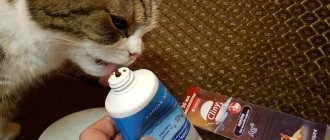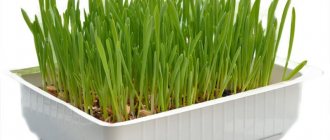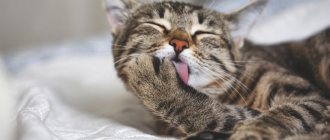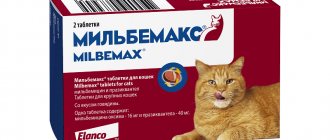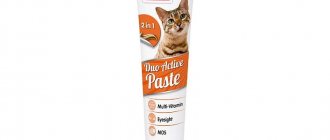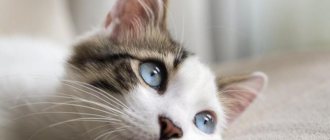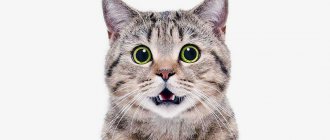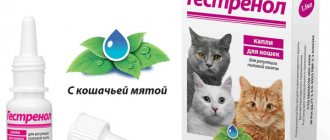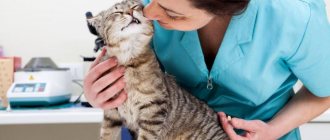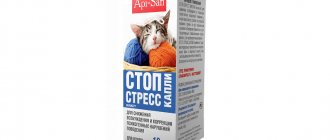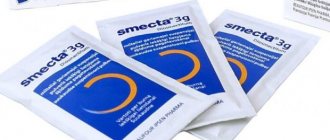Cats are clean animals that carefully care for their fur. Every day they lick the fur with their tongue, as a result of which some hairs enter the gastrointestinal tract, which is very unsafe for the cat. Wool clogs the intestines, causing abdominal pain, problems with digestion and stool. This can lead to the development of pancreatitis, gastritis and other gastrointestinal diseases.
Various methods are used to effectively remove hair from the stomach. Many veterinarians recommend using special malt pastes for this purpose.
In the article we will look at what malt paste is for removing hair from cats, the principle of action of the drug, how to use it correctly, contraindications, a review of popular pastes for hair removal, what other means will help cope with the problem
How does hair removal paste work?
Malt pastes for hair removal have a therapeutic and prophylactic effect.
:How the product works:
- When ingested, the paste envelops and softens hairballs, promoting their active elimination naturally, preventing vomiting and constipation in the cat.
- Improves the movement of hairballs through the intestines.
- Normalizes the normal functioning of the gastrointestinal tract.
- Restores intestinal microflora.
- Eliminates unpleasant symptoms - abdominal pain, vomiting, etc.
Thanks to the beneficial microelements it contains, malt paste also helps strengthen the immune system and has a positive effect on the condition of the skin and coat of animals.
What are trichobezoars
This is the scientific term for hairballs that lodge directly in the stomach. Their formation due to regular washing and regurgitation is a natural process for representatives of the cat family. In most cases, the formation of hairballs and their removal does not cause noticeable problems, but in long-haired cats negative consequences are much more common.
Due to the narrow lumen of the esophagus, trichobezoars take on a cylindrical shape. Inexperienced owners are often scared when their cat begins to vomit due to their breeding, but there is no need to panic.
In its structure, a cat's tongue resembles a grater - its rough surface combs the fur when washing, and collects hairs. Some of them are spat out by the pet, others go down the esophagus, lingering in the stomach or going into the intestines, from where they are released with feces.
Note! If your pet has short hair, this does not prevent the formation of lumps and fur in the stomach. The process is slower and the risk of complications is reduced, but the likelihood of trichobezoars remains, so owners should be aware of the symptoms of this phenomenon and methods for eliminating them.
Normally this occurs without complications, but if the formation in the stomach becomes too large, it cannot leave the body. This often happens in the case of:
- intensive licking during molting;
- metabolic disorders;
- hormonal imbalances;
- stress;
- lack of vitamins;
- as a result of impaired motility of the gastrointestinal tract.
The animals themselves have already developed a mechanism to eliminate the problem - eating grass. Wheatgrass helps to regurgitate accumulated hair, however, this is only possible if the cat is outside. The likelihood of developing trichobezoars is especially high in Maine Coons, Persian cats and other breeds with long hair.
Symptoms of Hairballs in Cats
The problem of hairballs forming in the stomach can even occur in kittens. Normally, every pet cleans its digestive tract by regurgitating fur from one to six times a month.
If this process does not occur naturally, the following symptoms may appear:
- constipation, too hard stool with pieces of six in the stool;
- regular vomiting with hair coming out;
- heat;
- the appearance of blood or mucus in the vomit;
- cough;
- refusal to eat due to a feeling of pressure in the intestines and stomach;
- copious amounts of saliva;
- swollen belly - the cat does not allow you to touch it because of the pain.
If your pet has several of the symptoms on the list and you clearly see fur in the stool or vomit, be sure to visit a veterinarian. Usually, to relieve symptoms, malt pastes are prescribed, which facilitate hair removal in cats with long hair and pets prone to the formation of hairballs.
Instructions and admission courses
Malt paste for cats has a pleasant taste and smell. Available in closed tubes of various sizes. Stored at temperature +5+250C.
The product can be used for treatment and prevention according to the instructions. For preventive purposes, a 7-day course of administration every month is recommended.
To relieve pain and quickly remove hair from the digestive system, the cat is given paste daily in a dosage of up to 3 cm. During the molting period, the dose increases to 5 cm. It is better to take the medicine 1-1.5 hours before or after meals.
The drug has a laxative effect, so it is not recommended to exceed the dosage indicated in the instructions.
Many cats are happy to consume malt paste in its pure form. If the animal refuses to take the medicinal composition, it can be mixed with food or added to ready-made food.
Contraindications and possible side effects
Malt paste is equally suitable for kittens, adult animals and older, weakened individuals. It has no other contraindications, except for serious pathologies of the digestive system and liver problems. Also, paste for cats is not prescribed in case of the formation of a large hairball that causes intestinal obstruction.
The drug has virtually no side effects. But the components present in its composition in rare cases cause allergies. Therefore, when using the wool dissolving paste for the first time, it is recommended to reduce the dose of the drug and look at the animal’s reaction. If the cat becomes restless and begins to itch, then this malt paste is not suitable for him.
Rating of the best pastes for removing hair from the stomach
Veterinary pharmacies and pet stores offer a large selection of malt pastes for cats from different global manufacturers. We have compiled a rating of the top 5 best therapeutic and prophylactic products for removing hair from the stomach of animals, showing high efficiency and safety of use.
Top 5 best malt pastes for cats:
- Cliny is a high-quality and inexpensive paste with silver ions from a Russian manufacturer.
- Gimpet is an imported paste with natural malt and vegetable oils, does not contain sugar. It has a distinct and attractive scent for cats.
- Beaphar is a Dutch-made product containing useful microelements, oils and products of plant origin. It tastes like caramel. Effectively removes hair from the stomach, removes toxins from the body, and strengthens the immune system.
- Sanal is a hair-removing paste with a meaty taste that improves digestion and appetite. Contains herbal ingredients, oils, fats and vitamin E. Produced in the Netherlands.
- Gimcat is a vitamin paste with a high content of ballast substances with natural aromatic malt and vegetable oils. Promotes the removal of swallowed hair and undigested food residues naturally. Produced in Germany.
Composition and principle of action of the paste
The main components of modern hair removal products are vegetable oils and fats, fiber, microcrystalline cellulose, dairy products, malt concentrate and ballast substances.
Some formulas have added TGOS - transgalactoolisocharides, which stimulate digestive activity and normalize the microflora of the large intestine. Recipes for combined products contain vitamins, absorbents and disinfectants, minerals and amino acids.
Operating principle of malt pastes
Hair removal products do not dissolve hairballs, but help remove them from the animal’s body.
Their second function is preventive. Pastes do not allow hairs that have entered the cat’s stomach to form large bezoars and grow into the intestinal walls.
How does this happen?
The malt and oils included in the formula of paste preparations envelop hairballs stuck in the animal’s gastrointestinal tract - this makes it easier to remove them out.
Wool is excreted from the cat's body with feces in an undigested and undigested form. In addition, the paste lubricates the intestinal walls, facilitating bowel movements.
Fiber and vegetable fats stimulate peristalsis of the intestinal wall - this normalizes stool and prevents constipation. Activating the intestines has a beneficial effect on the pet’s well-being, improves appetite, and prevents vomiting.
Pastes enriched with micro- and macroelements have a healing effect on the cat’s body:
- increase immunity;
- normalize the functioning of the liver and kidneys;
- improve wool quality;
- replenish reserves of micro- and macroelements.
Pros and cons of malt pastes
Advantages:
- Pleasant taste. Animals willingly eat the medicine.
- Effectively relieve constipation.
- There are no contraindications based on the age or condition of the animal.
- Compatible with other medications.
- Easy to dose.
- Do not cause addiction or allergies.
- Convenient to give along with food.
- The therapeutic effect is noticeable immediately.
The disadvantages of the product include the need for storage in the refrigerator and a long course of administration.
Important!
The formula does not contain addictive components, the active substances do not accumulate in the pet’s body - the drug can be used for a long period.
Analogues of malt paste for cats
There are also on sale therapeutic and prophylactic products for removing hair from the stomach, produced in other forms: tablet preparations, hair-removing food, etc. Let’s take a closer look.
Tablet drugs
You can replace malt paste with effective wool removal tablets based on phytocomplexes. Preparations from the VEDA brand, which produces the “Fitomina” line based on a multicomponent formula, have good reviews. Contains 12 plant extracts, taurine, natural minerals and other components beneficial to the cat's body.
Hair-reducing feed
To remove hairballs from a cat’s gastrointestinal tract, you can use special therapeutic and prophylactic food containing a large amount of plant fiber, which stimulates the motility of the digestive tract. Medicinal foods can become the basis of a cat’s diet or be used periodically for preventive purposes. The recommended duration of use is 2-6 months.
Food for hair removal:
- Daily Cat Adult Hairball Turkey and Rice – premium dry food;
- Almo Nature Functional Line – wet (canned), super-premium;
- Eukanuba Cat Hairball – dry, super-premium;
- Royal Canin Hairball Care – dry, premium and others.
Hair-bearing foods have some contraindications. Before use, read the instructions or consult a specialist.
Other means
Other effective means are used to remove hair from the stomach of pets.
Available analogues of malt paste:
- Vaseline oil – softens stool, acts as a laxative;
- vitamin-herbal complex “Nature” – a tableted product based on ballast components;
- “Nutri-Vet” is a preventive mixture of Omega-3 acids, vitamin complexes and beneficial macroelements;
- preventive pads based on malt paste - suitable for newborn kittens and adult animals;
- therapeutic and prophylactic capsules based on herbal ingredients and other effective products that improve digestion and quality of life for pets.
Malt paste and other hair removal products are an indispensable element of the veterinary first aid kit of every cat owner who cares about the health of their pet. You can purchase a therapeutic and prophylactic product in stationary pet stores and veterinary pharmacies in the city or via the Internet by placing a quick order online. Before using malt paste, be sure to read the instructions!
Reviews from consumers and veterinarians
Albina: “I have a Scottish fold. One day the cat started coughing and vomited a hairball. I called my veterinarian, he recommended purchasing Gimpet or Beafar hair removal medications. The pet store only had Klini, a Russian drug. The taste of the food additive immediately attracted the cat’s attention, and she licked it off my hand. The nausea stopped. Now I give her the paste every morning before breakfast.”
Sergey: “When I took my Persian to the nursery, I was immediately advised to buy hair removal paste for cats. The cat is long-haired and sheds heavily. I purchased the product “8 in 1 Excel” - it does its job perfectly. The cat has regular stools; hairballs are removed into the litter box. There is no vomiting or regurgitation. The cat has an excellent appetite. The wool is in perfect order.”
Arkady, veterinarian: “Malt pastes can hardly be called a medicine. This is a feed additive that can be taken on an ongoing basis without any harm to the pet’s health. The advantage of these drugs is that manufacturers add vitamins and minerals to them. Clients often come to me with the question: “Is it necessary to comb the cat if we give it malt paste?” Of course it is necessary. Scratching and bathing – no one can cancel these mandatory procedures. It is also important to promptly clean the cat’s bedding and habitat from accumulated hair.”
Svetlana Igorevna, veterinarian: “As an alternative to malt paste, I would recommend grass for cats. Some owners give their pets regular Vaseline from the pharmacy, but I still recommend not getting carried away with this, but buying specialized products. Veterinary pharmacies now have a good selection of drugs, both imported and domestically produced. The active ingredients of most of them are identical. You can choose malt paste according to your wallet. There are products with good formulas enhanced with vitamins, amino acids and minerals.”
Video
Pasta "Dzhimket"
This product is produced by the same German manufacturer. On sale you can find packaging of twenty, fifty, one hundred and two hundred grams. Such tubes cost on average from two hundred to five hundred rubles. In principle, the composition of the paste is the same, but cats eat it much more readily, as consumers note in their reviews. This product tastes and smells more pleasant. Therefore, almost all pets willingly eat the product directly from the tube.
The effect of the product is not long in coming; the paste does an excellent job of removing hair. In rare cases, after eating it, the animal has problems with stool. But cat owners still recommend this drug for purchase.
Symptoms of the presence of hairballs in a cat's stomach and what it means
Some symptoms can indicate that a cat's stomach is filled with fur. The most basic of them is lack of appetite. Food simply cannot fit into a full stomach. In this case, the pet usually walks around the bowl, but does not eat anything. This is due to the fact that the brain simultaneously receives signals about low glucose levels and a full stomach.
There are also symptoms such as:
- loss of shine in wool;
- cough, frequent vomiting;
- accumulation of hair on the fangs;
- lethargy, fatigue and apathy towards everything;
- constipation lasting several days.
What components are usually included?
Manufacturers of pet products offer a wide selection of malt pastes that differ in composition. But the components found in most are:
- Malt. This is the base of malt paste. It is a source of fiber and also a natural sweetener, which makes the taste of the paste attractive to cats.
- Fatty acid.
- Vitamins.
- Minerals.
- Prebiotics and probiotics.
Associated bonuses from consuming malt paste are: improving the external characteristics of the animal’s fur and strengthening it.
Malt paste is available in tubes. Before giving the cat paste , you need to read the instructions. The drug should be stored in the refrigerator. But to make it easier to squeeze out the thick mixture, it can be warmed to room temperature shortly before use.
Features of use in pregnant cats and kittens
If there is a pregnant cat or kitten living at home, the question may arise as to whether and how to give hair removal paste to a pregnant cat.
For small kittens there is no need to use the paste. Until they reach the stage where the mother cat teaches them, they do not lick themselves. But many pastes indicate that starting from three months the drug can be given to a kitten; for some manufacturers this period varies up to a year. The dosage is on average half that for an adult.
Due to its natural composition, there are no contraindications for pregnant cats. It is worth monitoring your cat's stool after starting use due to increased sensitivity to the drugs during pregnancy. If diarrhea occurs, the dosage should be reduced.
